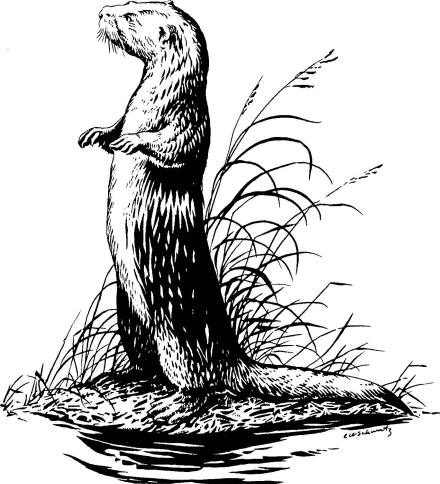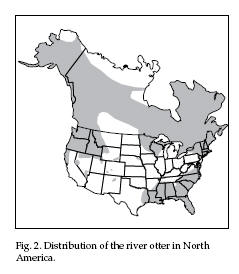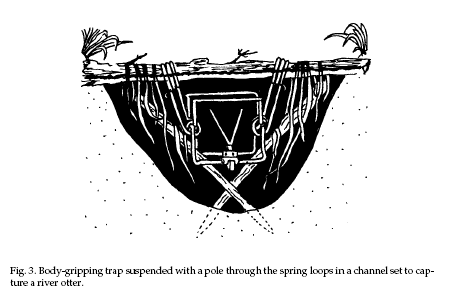|
|
|
|
 |
CARNIVORES: River Otters |
|
|

Fig. 1. The North American
river otter, Lutra canadensis
Identification
River
otters Lutra canadensis, Fig. 1) are best known for
their continuous and playful behavior, their aesthetic
value, and the value of their durable, high-quality fur.
They have long, streamlined bodies, short legs, and a
robust, tapered tail, all of which are well adapted to
their mostly aquatic habitat. They have prominent
whiskers just behind and below the nose, thick muscular
necks and shoulders, and feet that are webbed between
the toes. Their short but thick, soft fur is brown to
almost black except on the chin, throat, cheeks, chest,
and occasionally the belly, where it is usually lighter,
varying from brown to almost beige.
 Fig.
2. Distribution of the river otter in North America. Fig.
2. Distribution of the river otter in North America.
Adult males usually
attain lengths of nearly 48 inches (122 cm) and weights
of about 25 pounds (11.3 kg), but may reach 54 inches
(137 cm) and 33 pounds (15 kg). Their sex can be readily
distinguished by the presence of a baculum (penile
bone). Females have 4 mammae on the upper chest and are
slightly smaller than males. Female adults measure about
44 inches (112 cm) and weigh 19 pounds (8.6 kg). The
mean weights and sizes of river otters in southern
latitudes tend to be lower than those in latitudes
farther north.
Range and Habitat
River
otters occur throughout North America except the arctic
slopes, the arid portions of the Southwest, and the
intensive agricultural and industrialized areas of the midwestern United States (Fig. 2). Their precolonial
range apparently included all of North America except
the arid Southwest and the northernmost portions of
Alaska and Canada. Otter populations are confined to
water courses, lakes, and wetlands, and therefore,
population densities are lower than those of terrestrial
species. Their extirpation from many areas is believed
to have been related more to poisoning by pesticides
bio-magnified in fishes, and to the indirect adverse
effects of water pollution on fish, their main food,
than to excessive harvest. The loss of ponds and other
wetland habitat that resulted from the extirpation of
beaver in the late 1800s may have adversely affected
continental populations of river otters more than any
other factor. Increases in the range and numbers of
river otters in response to the return of beaver has
been dramatic, particularly in the southeastern United
States. Recent releases totaling more than 1,000 otters
have been made in Arizona, Colorado, Iowa, Kansas,
Kentucky, Missouri, Nebraska, Oklahoma, Pennsylvania,
Tennessee, and West Virginia in efforts to reestablish
local populations.
River otters are almost
invariably associated with water (fresh, brackish, and
salt water), although they may travel overland for
considerable distances. They inhabit lakes, rivers,
streams, bays, estuaries, and associated riparian
habitats. They occur at much higher densities in regions
of the Great Lakes, in brackish marshes and inlets, and
in other coastal habitats than farther inland. In colder
climates, otters frequent rapids and waterfall areas
that remain ice-free. Vegetative cover and altitude do
not appear to influence the river otter's
distribution as much as do good or adequate water
quality, the availability of forage fish, and suitable denning sites.
Food Habits
The diet of
the river otter throughout its range is primarily fish.
Numerous species and varieties of fresh and anadromous
fishes are eaten, but shellfish, crayfish, amphibians,
and reptiles are also frequently eaten, as are several
species of crabs in coastal marshes. Mammals and birds
are rarely eaten. Consumption of game fishes in
comparison to nongame (rough) fishes is generally in
proportion to the difficulty, or ease, with which they
can be caught. Because of the availability of abundant
alternate food species in warm water, losses of the warm
water sport fishes are believed minor compared to losses
river otters can inflict on cold water species such as
trout and salmon.
General Biology,
Reproduction, and Behavior The reproductive biology of
river otters and all other weasels is complex because of
a characteristic known as delayed implantation.
Following breeding and fertilization in spring, eggs (blastocysts)
exist in a free-floating state until the following
winter or early spring. Once they implant, fetal growth
lasts 60 to 65 days until the kits are born, usually in
spring (March through May) in most areas. In the
southern portion of the range the dates of birth occur
earlier, mostly in January and February, implying
implantation in November and December. Litters usually
contain 2 to 4 kits, and the female alone cares for the
young. They usually remain together as a family group
though the fall and into the winter months. Sexual
maturity in young is believed to occur at about 2 years
of age in females, but later in males.
River otters are
chiefly nocturnal, but they frequently are active during
daylight hours in undisturbed areas. Socially, the basic
group is the female and her offspring. They spend much
of their time feeding and at what appears to be group
play, repeatedly sliding down steep banks of mud or
snow. They habitually use specific sites (toilets) for
defecation. Their vocalizations include chirps, grunts,
and loud piercing screams. They are powerful swimmers
and are continuously active, alert, and quick—characteristics
that give them immense aesthetic and recreational value.
Their webbed feet, streamlined bodies, and long, tapered
tails enable them to move through water with agility,
grace, and speed. Seasonally, they may travel distances
of 50 to 60 miles (80 to 96 km) along streams or lake
shores, and their home ranges may be as large as 60
square miles (155 km2). Males have been recorded to
travel up to 10 miles (16 km) in 1 night.
River otters use a
variety of denning sites that seem to be selected based
on availability and convenience. Hollow logs, rock
crevices, nutria houses, and abandoned beaver lodges and
bank dens are used. They will also frequent unused or
abandoned human structures or shelters. Natal dens tend
to be located on small headwater branches or streams
leading to major drainages or lakes.
Damage and Damage
Identification
The presence of river otter(s) around or
in a fish hatchery, aquaculture, or fish culture
facility is a good indication that a damage problem is
imminent. Otter scats or toilets that contain scales,
exoskeletons, and other body parts of the species being
produced is additional evidence that damage is ongoing.
Uneaten parts of fish in shallow water and along the
shore is evidence that fish are being taken. Otters
usually eat all of a small catfish except for the head
and major spines, whereas small trout, salmon, and many
of the scaled fishes may be totally eaten. Uneaten
carcasses with large puncture holes are likely
attributable to herons. River otters can occasionally
cause substantial damage to concentrations of fishes in
marine aquaculture facilities. Often the damage involves
learned feeding behavior by one or a family of otters.
Legal Status
The river
otter is listed in Appendix II of the Convention on
International Trade in Endangered Species of Flora and
Fauna (CITES). Its inclusion in this appendix subjects
it to international restrictions and state/province
export quotas because of its resemblance to the European
Otter. Moreover, the river otter is totally protected in
17 states. Twenty-seven states have trapping seasons,
and four states and two provinces have hunting seasons.
Damage Prevention and
Control Methods
Because river otter damage has been
minor compared to that of other species, and because of
its legal status under the CITES Agreement, little
control research and experimentation has been done.
Registration of repellents, toxicants, or fumigants for
river otter control has not been sought. Alternate aquacultural practices and species, predator avoidance
behavior, and use of protective habitat have not been
fully explored. Careful assessment should be made of
reported damage to determine if nonlethal preventative
measures can be employed, and to ensure that if any
lethal corrective measures are employed, they do not
violate state or federal laws. Damage problems should
then be approached on an individual basis. Cultural
methods and habitat modification are normally not
applicable. Opportunities to use repellents, toxicants,
fumigants, and frightening devices are infrequent, yet
the development of any of these or other effective
nonlethal approaches would be preferable to lethal
control measures.
Exclusion
Fencing with
3 x 3-inch (7.6 x 7.6-cm) or smaller mesh wire can be an
economically effective method of preventing damage at aquacultural sites that are relatively small, or where
fish or aquaculture activities are concentrated. Fencing
is more economical for protection of small areas where
research, experimental, or propagation facilities such
as raceways, tanks, ponds, or other facilities hold
concentrations of fish. Hog wire-type fences have also
been used effectively, but these should be checked
occasionally to ensure that the lower meshes have not
been spread apart or raised to allow otters to enter.
Electric fences have
also been used, but they require frequent inspection and
maintenance, and like other fencing, are usually
impractical for protecting individual small ponds,
raceways, or tanks in a series. They are of greater
utility as a supplement to perimeter fences surrounding
an aquaculture facility.
Trapping
Traps that
have been used effectively for river otters include the Conibear® (sizes 220 and 330) or other similar
body-gripping traps and leghold traps (modified No. 1
1/2 soft-catch and No. 11 double longspring). The latter
two are usually employed to capture river otters for
restocking purposes. In water, body-gripping traps are
usually placed beneath the water surface or partially
submerged where runs become narrow or restricted (Fig.
3). They are effective when partially submerged at dam
crossings, the main runs in beaver ponds, or other
locations where otters frequently leave the water.
Body-gripping traps are also effective in otter trails
that connect pools of water or that cross small
peninsulas. In these sets, the trap should be placed at
a height to blend with the surrounding vegetation to
catch an otter that is running or sliding. After ice
forms on the surface of streams and lakes, some trappers
bait the triggers of body-gripping traps with whole
fish. River otter trapping is prohibited in 21 states
and one Canadian province. Check local regulations
before trapping.
 Most
of the wild otters used for restocking in recent years
were caught with No. 11 longspring traps in coastal
Louisiana. These animals were usually caught in sets for
nutria, in traps that were set in narrow trails and
pullouts where shallow water necessitated that otters
walk rather than swim. Leghold traps are also effective
when placed in shallow edges of trails leading to otter
toilets or other areas they frequent. Leghold traps set
in out-of-water trails and peninsula crossings should be
covered with damp leaves or other suitable covering. Most
of the wild otters used for restocking in recent years
were caught with No. 11 longspring traps in coastal
Louisiana. These animals were usually caught in sets for
nutria, in traps that were set in narrow trails and
pullouts where shallow water necessitated that otters
walk rather than swim. Leghold traps are also effective
when placed in shallow edges of trails leading to otter
toilets or other areas they frequent. Leghold traps set
in out-of-water trails and peninsula crossings should be
covered with damp leaves or other suitable covering.
With the depression of
fur prices, nuisance beaver problems and efforts to
control them have increased substantially throughout the
United States. The killing of otters during beaver
control trapping can be minimized by using snares, but
they do occasionally sustain moderate injuries. In most
situations, snared river otters can be released
unharmed. Accordingly, snares are neither the most
effective, nor the most convenient devices for capturing
river otters or removing them from an area, and
therefore are not recommended for either.
Shooting
Shooting the
offending otters that cause damage problems will often
effectively prevent continued losses. Although otters
are shy, they are inquisitive and will often swim within
close range of a small rifle or shotgun. Extreme caution
should be taken to avoid ricochet when shooting a rifle
at objects surrounded by water.
Shooting river otters
for fur harvest is legal in four states and one Canadian
province. Check your local, state, and federal laws and
permits governing shooting, the use of lights after
dark, the seasons, and the possession of otter carcasses
or parts, to ensure that planned activities are legal.
Economics of Damage and
Control
Although individual incidences of river otter
damage and predation on fish can cause substantial
losses to pond owners and to fresh water and marine aquacultural interests, their total effects are believed
to be insignificant. Given the otter’s aesthetic
and recreational value, and its current legal status,
consideration of broad control programs are unwarranted
and undesirable.
Acknowledgments
Figure
1 from Schwartz and Schwartz (1981).
Figure 2 from Toweill
and Tabor (1982), adapted by Dave Thornhill, University
of Nebraska-Lincoln.
Figure 3 by Clint
Chapman, University of Nebraska-Lincoln.
For Additional
Information
Hill, E. P. 1983. River otter Lutra
canadensis Pages 176-181 in E. F. Deems Jr. and D.
Pursley eds. North American furbearers, a contemporary
reference. Internat. Assoc. Fish Wildl. Agencies and
Maryland Dep. Nat. Resour.
Hill, E.P., and V.
Lauhachinda. 1980. Reproduction in river otters from
Alabama and Georgia. Pages 478-486 in J. A. Chapman and
D. Pursley eds., Proc. worldwide furbearer conf.
Maryland Dep. Nat. Resour., Annapolis.
Melquist, W. E., and
Ana E. Dronkert 1987. River otter. Pages 626-641 in M.
Novak, J. A. Baker, M. E. Obbard, and B. Malloch eds.
Wild furbearer management and conservation in North
America. Ontario Minister of Nat. Resour., Toronto.
Toweill, D. E., and J.
E. Tabor. 1982. River otter. Pages 688-703 in J. A.
Chapman and G. A. Feldhamer eds. Wild mammals of North
America: biology, management, and economics. The Johns
Hopkins Univ. Press., Baltimore, Maryland.
Editors
Scott E. Hygnstrom
Robert M. Timm Gary E. Larson
PREVENTION AND CONTROL
OF WILDLIFE DAMAGE — 1994
Cooperative Extension
Division Institute of Agriculture and Natural Resources
University of Nebraska -Lincoln
United States
Department of Agriculture Animal and Plant Health
Inspection Service Animal Damage Control
Great Plains
Agricultural Council Wildlife Committee
01/23/2007
Special
thanks to:
Clemson University
|